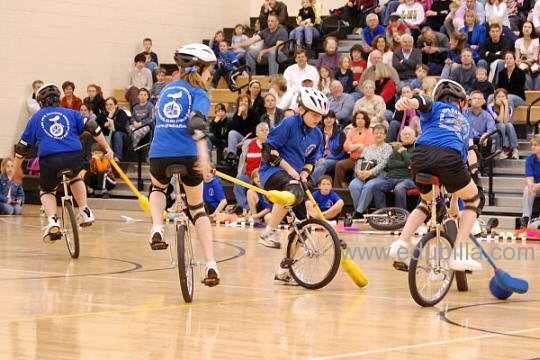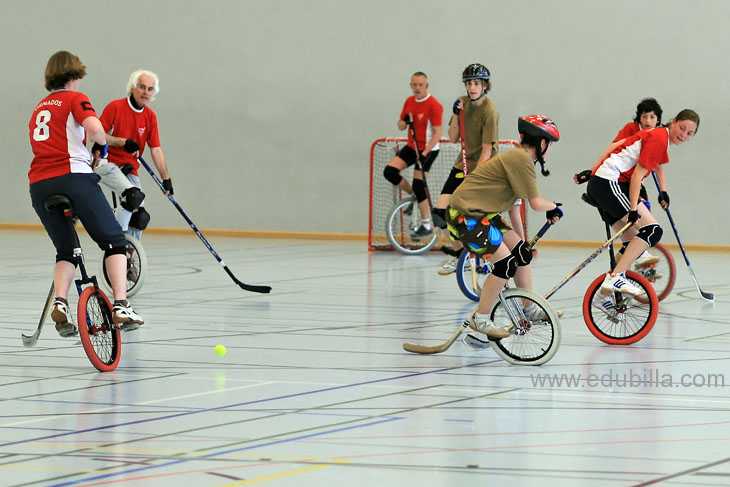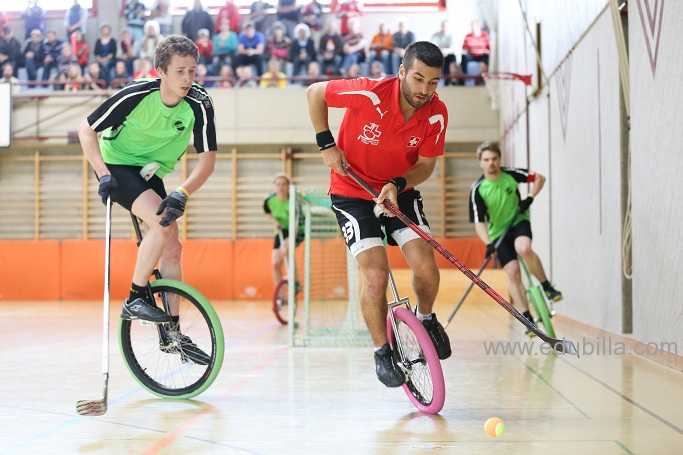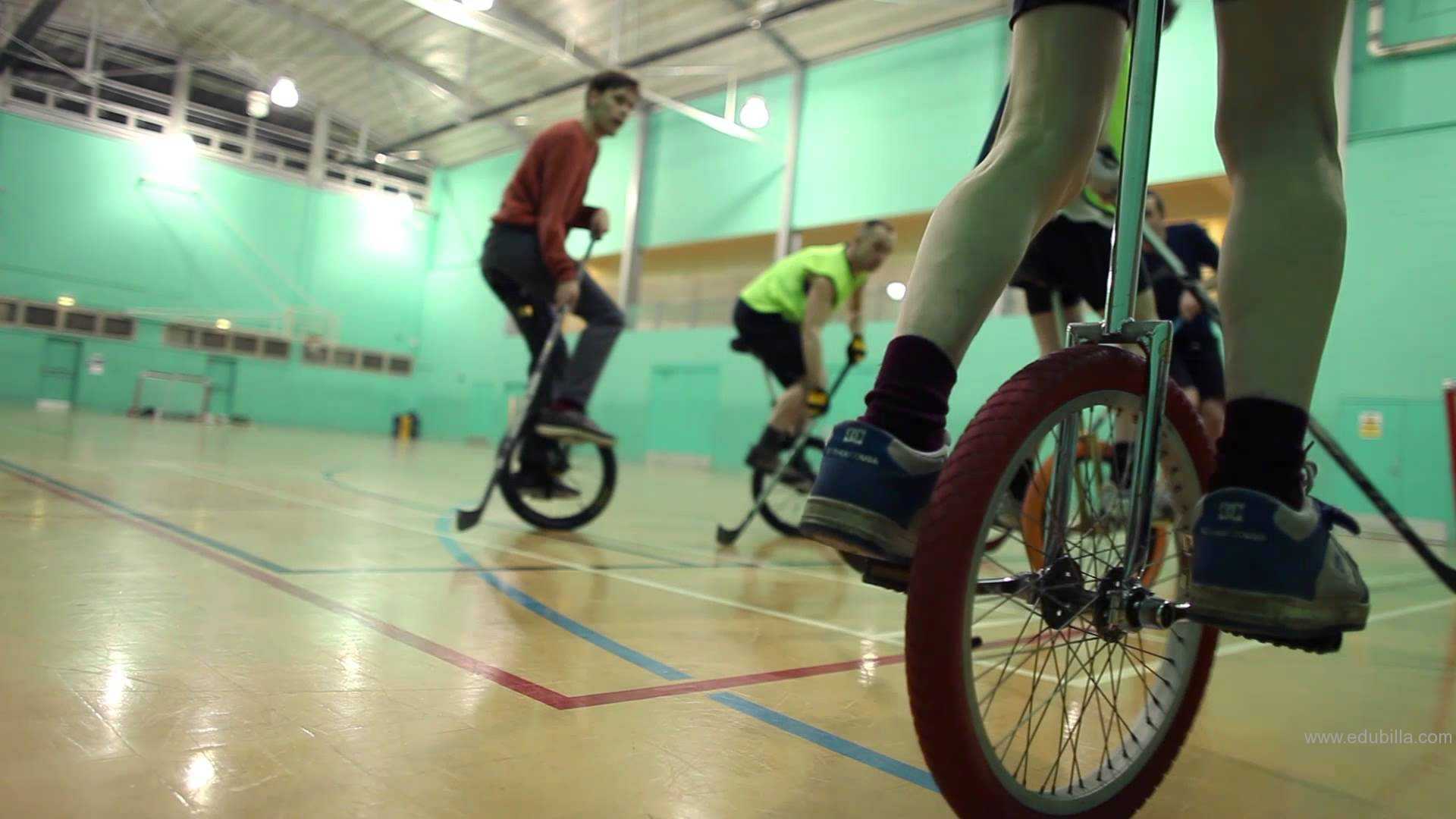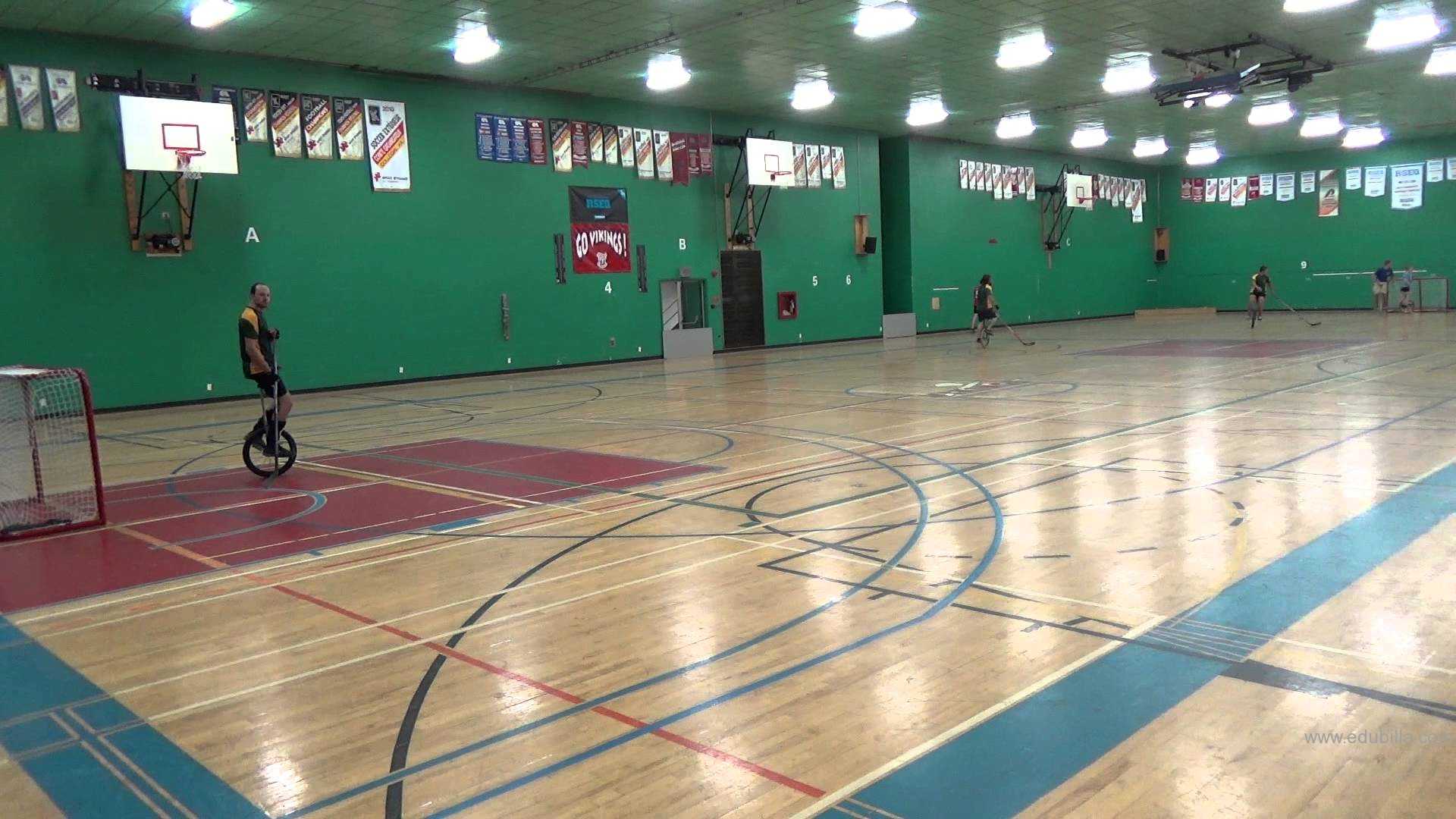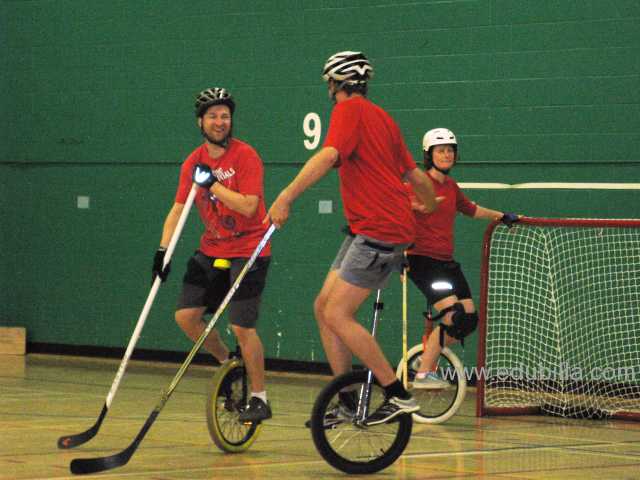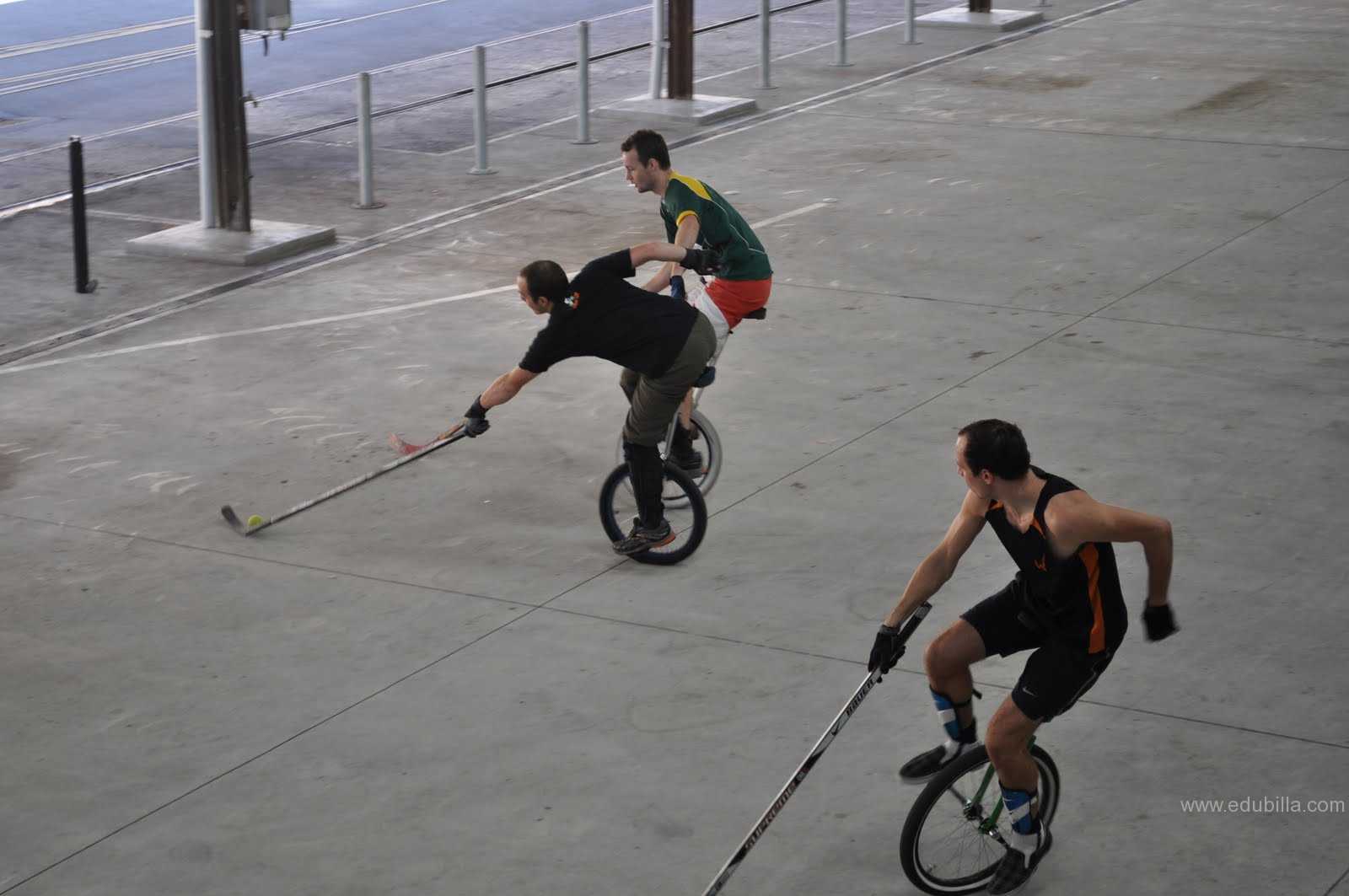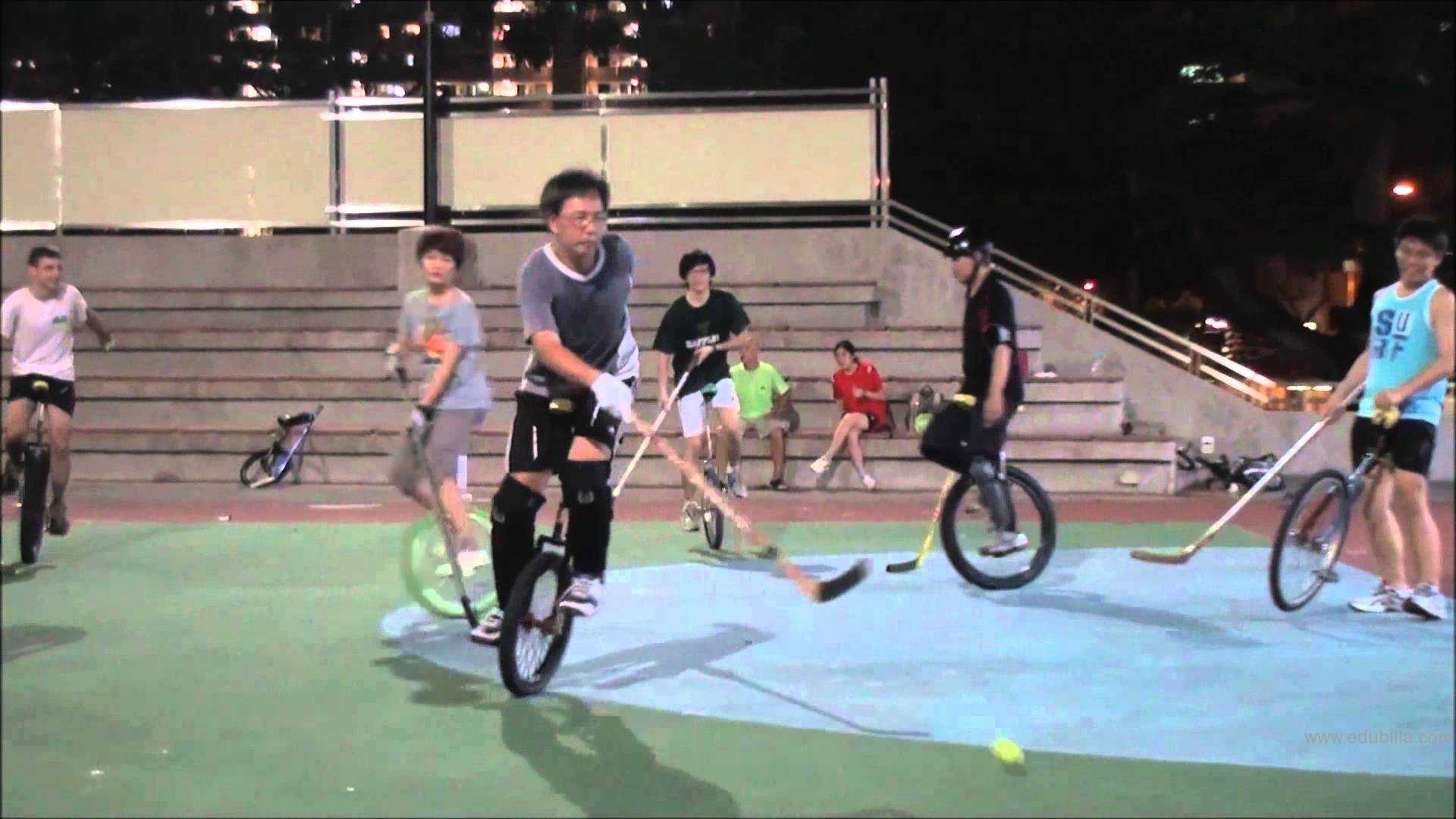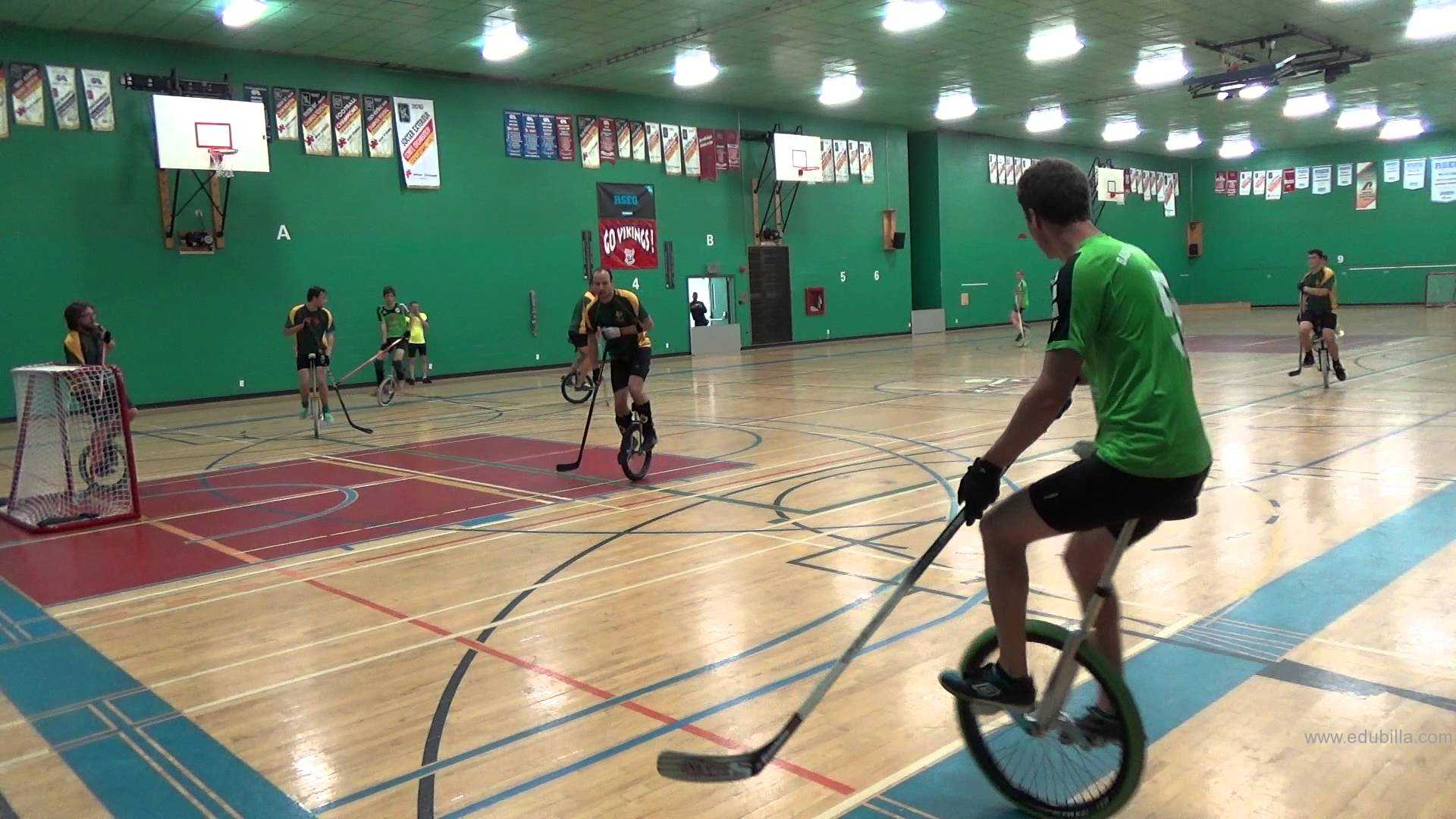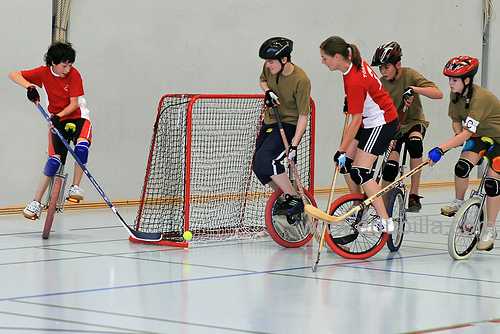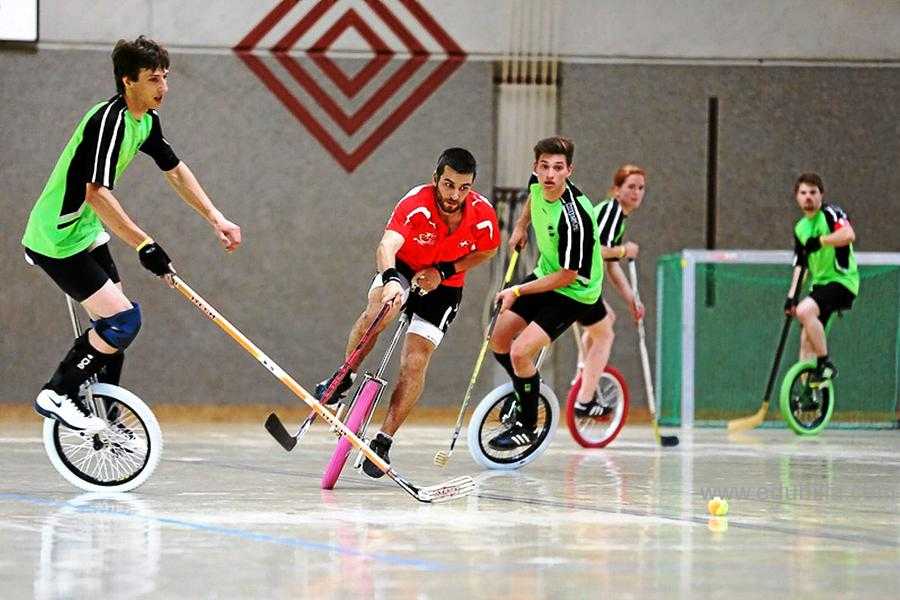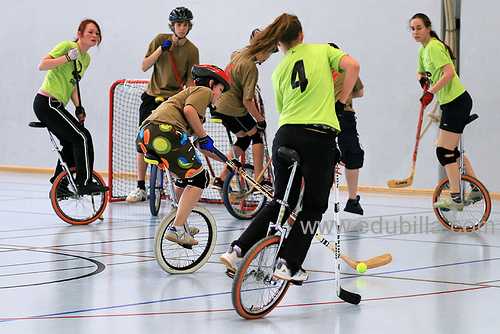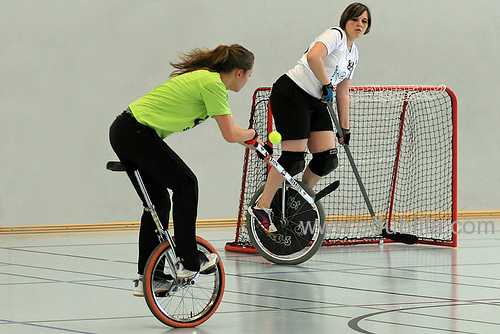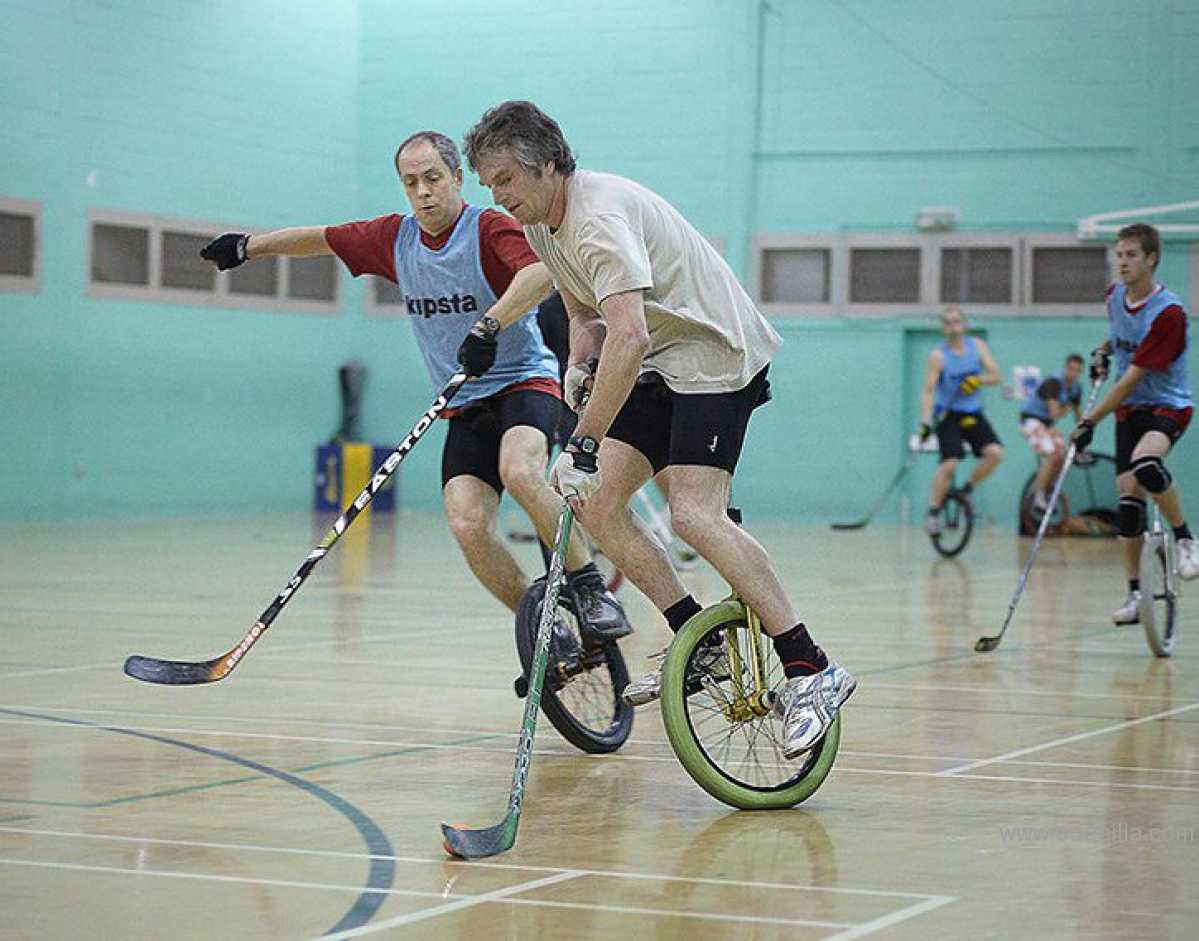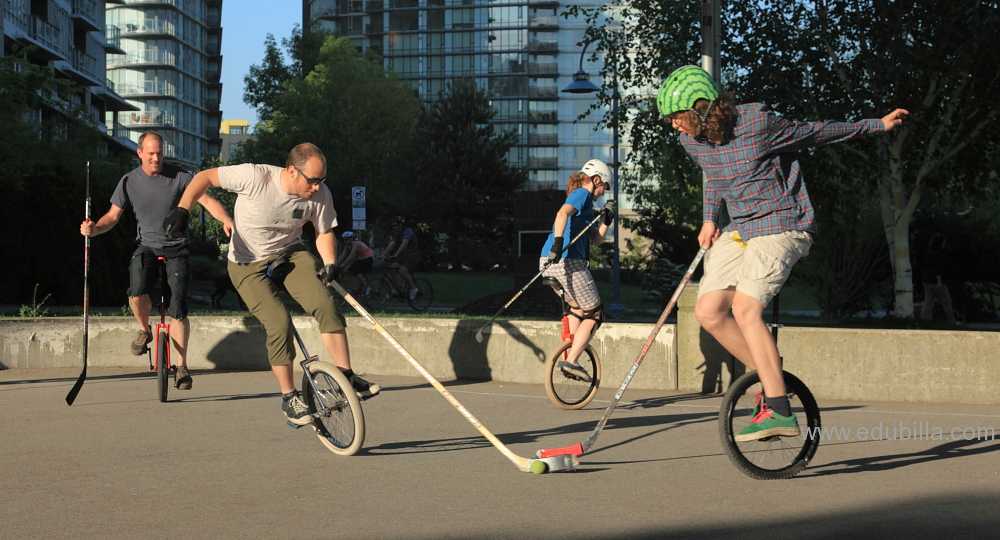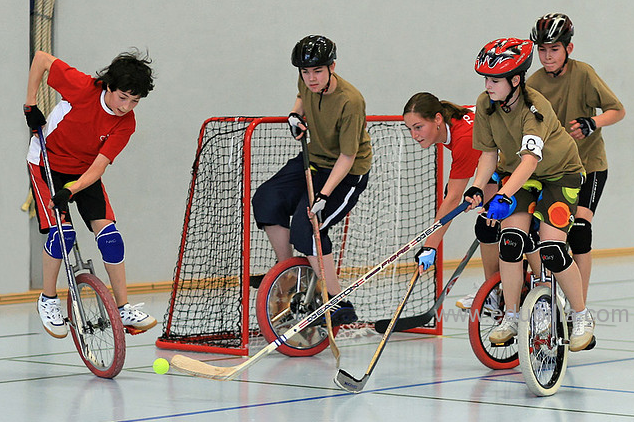
Overview Of Unicycle hockey
Unicycle hockey is a team sport, similar to roller or inline hockey, except that each player must be mounted on a unicycle (with both feet on the pedals) to play the ball. A team is composed of five players (plus substitutes), but there is no dedicated goalkeeper role (although one player usually stays back in that position).
Unicycle Hockey is a team sport, similar to roller or inline Hockey, except that each player must be mounted on a unicycle (with both feet on the pedals) to play the ball. A team is composed of five players (plus substitutes), but there is no dedicated goalkeeper role played by some clubs.
National Unicycle Hockey Leagues:
There are four national unicycle hockey leagues: in the UK, with 10 registered teams; in Germany, where there are 53 registered teams, in Switzerland, with approximately 20 teams, and from 2014 in Australia. In addition to these leagues, there are clubs and teams in other countries, including France, Denmark, Sweden, Hong Kong, Singapore and Korea
Popularity:
Unicycle-Hockey in the Media:
TV:
The first time unicycle hockey was mentioned on German tv was in the 'WWF club'.There was hardly enough space to ride a uni, forget about playing hockey in thestudio. In 'Gesucht-Gefunden' some strange looking unicycles made by Takafumi Ogasawara were shown and we also had a chance to announce that we are still looking for more players. The moderator was pretty stupid. She was probably thinking about cars when she mentioned that Takafumi Ogasawara had made a trip around the world IN a unicycle. 'Geld oder Liebe' is a game show where the candidates have to have an extraordinary hobby. Unicycle-hockey players were asked twice already to become candidates. The first live game on tv ever was shown in 1991 in 'Fernsehgarten'. It was moderated by the former world champion on the horizontal bar, Eberhard Ginger. After trying one day he even managed to ride a few meters. In 'aktuelle Stunde' two players gave interviews about the sport. The Frankfurt team RADLOS was presented in 'Hessen Report'. The companion video to the 1996 edition of the Encyclopedia of the Bike Culture Quarterly magazine shows a short clip of a unicycle hockey game, right after a clip of someone riding a swing bike, which is a sort of unicycle with a front wheel.
Radio:
Unicycle-hockey has been on the radio. Some of us from LAHIMO gave interviews to 'Radio Bergisch Land' while the others were playing hockey, which gave a nice sound in the background.
In Claremont, California, KSPC (a college radio station servicing the Claremont Colleges) broadcast several minutes of a Uni hockey game. They cut to the broadcaster at the game several times throughout another radio program. It was a successful experiment, and more broadcasts are being planned.
Game Rules
1) PLAYING FIELD
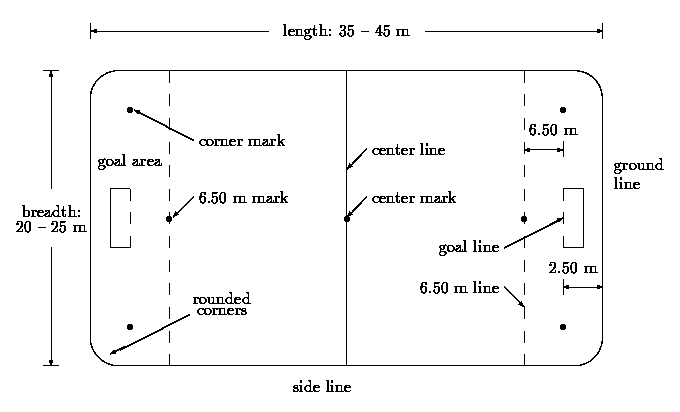
1.1) DIMENSIONS
The field has a length of 35 to 45 meters and a breadth of 20 to 25 meters. It is surrounded by barriers. The corners are rounded or beveled.
1.2) GOALS
The posts are 2.50 m in from the ends of the playing field (ground lines), ensuring that the players can go behind them. The inside dimensions of goal openings are 1.20 m high and 1.80 m wide. The goals must be made in such a way that the ball cannot enter through the rear or sides. The goals must not have sharp, pointed or protruding parts.
1.3) MARKINGS
The center line divides the field into two equal halves. There is a mark in front of each goal at a distance of 6.5 m. The goal lines connect the posts on the ground. The corner marks are on the extension of the goal lines, 1 m in from each side line. The 6.5 m lines are parallel to the goal lines and run through the 6.5 m marks. The goal areas are between the 6.5 m lines and the ends of the field.
2) TEAMS
2.1) NUMBER OF PLAYERS
A team consists of 5 players (plus substitutes). Substituting one player for another is possible at every interruption of the game if indicated to the referee. Each player can be the goal keeper at any time. The goal keeper has no special rights. To take part in a game, a team must have at least 3 players.
2.2) CLOTHING
Shoes must be worn. All players of a team must wear tricots of the same color. The color must be clearly different from the opponent's color. At tournaments and other large events each team should have two different colored sets of tricots. Clothing suggestions for comfort and safety:
- Cycling shorts and kneepads, or long pants
- Gloves
- Short shoe laces, or laces tucked in
- Helmet and dental protection
- Definitely no jewelry (watches, necklaces, earrings)
3) EQUIPMENT
UNICYCLES,STICKS,BALL
4) PENALTIES
In every instance of a violation of the rules the referee must penalize the offending team, unless the referee decides not to interrupt the game (advantage). The referee must start the game after any interruption.
4.1) FREE SHOT
The free shot is executed from the point where the violation was done. Exception: If a team gets a free shot within the opponents' goal area, the free shot is done from the closest corner mark (corner shot). The free shot is indirect. The player executing the free shot may only touch the ball once. Then another player has to touch the ball. Opposing players must keep a distance with their unicycles and their sticks of at least 2 m from the ball.
4.2) 6.5 M
If legal playing would have led to a direct chance to score a goal, a "6.5 m" is given. This includes fouls outside the goal area. The ball is placed at the 6.5 m mark. A player of the defending team goes to the goal. The other team chooses a player to shoot the 6.5 m. All other players must leave the goal area. After the referee's whistle the goal keeper must ride the unicycle freely and not rest on the goal. The attacking player has 3 seconds to make one shot. If no goal is scored, play continues as soon as the ball touches the post, the keeper touches the ball or the ball crosses the extended goal line.
4.3) PENALTY BOX
The referee can send a player off the field for 2 minutes, 5 minutes or for the remainder of the game. This is done in the case of unsporting behavior or intentional, dangerous disregard of the rules. While a player is in the penalty box, the team may not substitute a replacement for that player.
4.4) PENALTY GOAL
If the defending team prevents a goal from being scored through an illegal play of the ball and if, in the opinion of the referee, the ball was traveling directly toward the goal and would definitely have entered the goal without being touched by another player, a penalty goal may be awarded. In this case the attacking team is awarded a goal. If there is any doubt as to the certainty of a goal, a 6.5 m must be awarded as described in section 4.2.
5) COURSE OF THE GAME
5.1) GAME DURATION
All times mentioned refer to actual playing time. The time is stopped at interruptions. There are two 15 minute halves, separated by a 5 minute break. The teams change sides during the break. If the game ends in a draw and a decision is necessary, play is continued for 10 more minutes: 5 minute break and change sides, 5 minutes of play, change sides without a break and 5 more minutes of play. If it's still a draw, each of the 5 current players from each team shoots a 6.5 m. If it's again still a draw, each team shoots one more 6.5 m until there is a decision.
5.2) RIDING THE UNICYCLE
The player has to be riding the unicycle freely. He or she may use the stick as support but must not rest on the goal or the wall or something similar. A short support on the wall to avoid a dismount should be tolerated by the referee. A player who is falling off the unicycle may take part in the game until touching the ground. A player who is off the unicycle must not be an obstacle for opponents. The player is considered an obstacle if the player, the unicycle or stick is hit by the ball and also if an opponent cannot move around freely. The player should remount at the same spot, but if necessary move out of the way of play first.
5.3) CONTACT WITH THE BALL
The stick, the unicycle and the whole body can be used to play the ball. It all counts as a contact. Players are not allowed to play the ball with the body twice in a row. The ball may only be guided with the stick but not with the body. For arms and hands see also section 7.1.
5.4) ALLOTMENT OF THE BALL
Each game period starts with a bully (face off) in which the referee drops the ball between two opposing players onto the center mark. Playing starts when the ball touches the ground.
5.5) RESTART AFTER A GOAL
After a goal, the non-scoring team gets the ball. All players must go to their own half. The game resumes when the ball or a player of the team in possession crosses the center line.
5.6) BALL OUT OF BOUNDS
If the ball leaves the field, the team opposite to that of the player who last touched it gets a free shot or a corner shot, depending where the ball went out. A free shot is done 1 m in from the side line.
5.7) MOVING THE GOAL
If a player moves the goal, the game is interrupted and the opposing team gets a free shot.
5.8) BALL IN SPOKES
If the ball gets stuck between the spokes of someone's unicycle, the opposing team gets a free shot.
6) FOULS
6.1) GENERAL CONSIDERATIONS
All players must take care not to endanger others. The game is contactless, i.e., the opponents and their unicycles may not be touched. You may touch an opponent's stick with your stick to block him. However, this contact may not be hard.
6.2) RIGHT OF WAY
- To keep the game going, rule violations that do not influence the course of the game should not be penalized. The following rules apply when riders come into contact with each other:
- No player may endanger another player by forcing him to give way (e.g., to push him toward the wall).
- A player who is idling must be evaded.
- The leading of two players riding next to each other may choose the direction of turns. If both are evenly side by side, the one having the ball may choose the direction.
- If two players are approaching each other directly or at an obtuse angle, the one with the ball has the right of way.
- In all cases not mentioned above, it is up to the referee to make a decision.
6.3) SUB (STICK UNDER BIKE)
A player who holds his or her stick in a way that someone else rides over or against it is committing a foul, regardless of intention. According to the situation the player who was "subbed" is given either a free shot or a 6.5 m.
6.4) SIB (STICK IN BIKE)
If a stick gets into the spokes of an opponent, the holder of the stick is committing a foul regardless of intention. According to the situation the player who was "sibbed" is given a free shot or a 6.5 m.
6.5) INTENTIONAL FOULS
Intentional fouls are considered to be unsporting behavior. The respective player is sent off the field for at least 2 minutes.
7) GOAL SHOTS
Restrictions 7.1 and 7.2 are not valid if the ball is shot into one's own goal. After a disallowed goal the defending team gets the ball.
7.1) GOAL SHOT WITH ARMS OR HANDS
A goal is disallowed if scored with arms or hands.
7.2) LONG SHOT
A goal is disallowed if the ball was shot from one's own half and was not touched by anyone afterwards.
7.3) GOAL SHOT THROUGH THE NET
If the ball entered the goal through the net from the side or the back, e.g., through a hole in the net, the goal is disallowed and the opposing team gets a free shot.
8) SAFETY RULES
8.1) THROWING STICKS
A player who intentionally drops or throws his or her stick is sent off the field for at least 2 minutes, at the discretion of the referee. Also, the opposing team gets a 6.5 m.
8.2) TOP OF THE STICK
The upper end of the stick must always be covered with one hand to avoid injury to other players.
8.3) THE LOWER END OF THE STICK
The lower end of the stick must always be below the players' hips. Each player must take care not to hit an opponent with his or her stick, especially after a shot.
8.4) INJURIES
The referee must suspend the game if an injury occurs. Afterwards, a free shot is given to the team that was in possession of the ball at the time of the interruption.
Equipments Need For Unicycle hockey
UNICYCLES:
For international competitions, the maximum wheel size is 24". The unicycles must not have sharp or protruding parts anywhere which might cause injuries. This refers especially to quick-release levers and bolts. The pedals must be plastic or rubber.
STICKS:
All sticks legal for playing ice-hockey (apart from those for the goalkeeper) can be used. Cracked or splintered sticks must be taped or repaired before play. An upper end made of rubber is recommended.
BALL:
The type of ball used depends on the region. In some areas a "dead" tennis ball that reaches 30 to 50 percent of its original height after bouncing onto concrete is used. In other areas street hockey balls are used. For international competitions, the choice is made by the hosting organization if the opposing teams do not agree on which ball to use. The chosen type of ball must be announced well in advance of the competition, and must be obtainable in all participating countries.
History Of Unicycle hockey
Unicycle hockey began in the early 1960's with the Albuquerque Unicycle Club. Hockey was just one of the activities they did on unicycles. The first club that formed solely for the purpose of playing hockey on unicycles was the Wheel People in mind 1970s California. The sport increased popularity shortly after in Europe. The first world championship was held in 1994 in Minneapolis. There were eight participating teams.
The first Bicycle:
For all practical intents and purposes, this was the first thing to actually qualify as a bicycle. Invented by a German Baron named Karl von Drais in 1817.It was a success, which saw some popularity in both Germany and France.
Later on this bike, which became known as the Draisine, shifted from its common use to versions that were designed specifically to be used on railroads (which meant 4 wheeled versions), however despite that, this bike was the beginning of cycling’s 200 year 2-wheeled reign.
The first unicycle:
During 1866, James Stanley invented a unique bicycle called the Penny Farthing. It is this vehicle that is thought to be the inspiration for the unicycle.
During the late nineteenth century the Penny Farthing was a popular bicycle. It had a large front wheel and a small rear wheel. Since its pedal cranks were connected directly to the front axle, the rear wheel would go up in the air and the rider would be moved slightly forward. This likely prompted riders to see how long they could ride with the back wheel in the air and the unicycle was born. Evidence for this theory of development can be found in pictures from the late eighteenth century that show unicycles with large wheels.
The Bicycle Journal:
According to an article in "The Bicycle Journal" (Aug 1960), the Albuquerque Unicycle Club (New Mexico, USA) played hockey, amongst other activities on the unicycle. Around 1962 Columbia unicycles came with a little pamphlet suggesting what you can do on a unicycle. One of their drawings shows people playing unicycle hockey.
First Unicycle-hockey Team:
In Germany the first unicycle-hockey team was LAHIMO. They started playing in 1985 some time after Takafumi Ogasawara had become tired of traveling around the world with his unicycle and had settled down in Monheim. He simply gave Christoph Verholt and Jochen Loeffelmann unicycles and told them to learn how to ride. Two months later they had a demo-game at a local event. Since then
Christoph has basically run the club. Until 1990, LAHIMO was the only German team. Then Jens Stemminger saw unicycle hockey at the European juggling convention 1990 in Oldenburg. He founded the Uniwheelers in Bremen. In 1991 Jojo Muehlmeyer and Rolf Sander from LAHIMO moved to the vicinity of Frankfurt. There they met Robert Mager, Martin Simeth and other enthusiastic unicyclists. They founded RADLOS in Frankfurt on 27 May 1991. Since then many other clubs have formed. A group of friends in Bochum saw unicycle-hockey on television. None of them could really ride a unicycle but they decided they wanted to play hockey. Meanwhile Bochum is one of the strongest teams in the German league.
First National Competition:
The first national unicycling Hockey competition in the UK was in 1988, at Covent Garden, London.
World Unicycling Championships (UNICON):
In 1994 the World unicycling championships (UNICON) were in Minneapolis, Minnesota, USA. For the first time a Hockey tournament was included. Eight teams participated: Bochum (Germany), Canada, Germany, LAHIMO (Germany), Puerto Rico, TCUC (USA), USA, and a mixed team. Germany beat LAHIMO 10 to 9 in a very exciting championship final.
Origin Of Unicycle hockey
Variety (1925 film):
Varieté is a 1925 silent drama film directed by Ewald Andre Dupont - This film is believed to be the first documentation of unicycle Hockey – it contains a short sequence showing two people playing the game on a small stage, one player is using a Field Hockey stick - Circus Comedy.
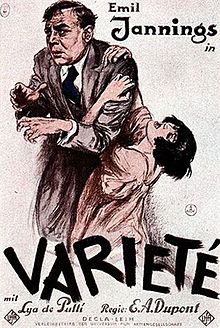
First Article:
The 1st mention of Unicycle Hockey was in The Bicycle Journal, August, 1960 with a article about the Albuquerque Unicycle Club in New Mexico, USA.
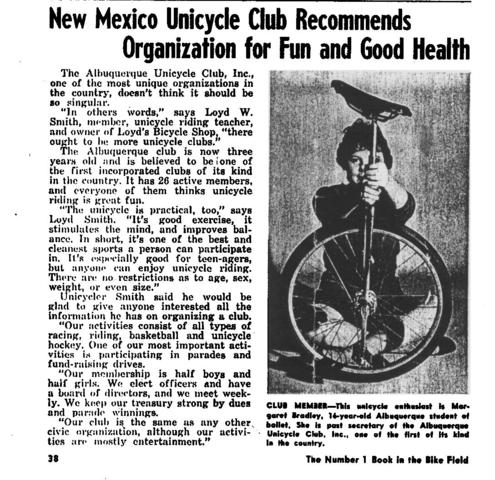
Unique Hockey Sticks:
Unicycle Hockey was played in Japan in 1971. Note the unique Hockey sticks.
First Unicycle-Hockey Team:
The first unicycle-Hockey team was LAHIMO. They started playing in 1985 some time after Takafumi Ogasawara had become tired of traveling around the world with his unicycle and had settled down in Monheim. He simply gave Christoph Verholt and Jochen Löffelmann unicycles and told them to learn how to ride. Two months later they had a demo-game at a local event.
First Unicycle-Hockey Club:
Christoph has basically run the club. Until 1990, LAHIMO was the only German team. Then Jens Stemminger saw unicycle hockey at the European juggling convention 1990 in Oldenburg. He founded the Uniwheelers in Bremen. In 1991 Jojo Mühlmeyer and Rolf Sander from LAHIMO moved to the vicinity of Frankfurt. There they met Robert Mager, Martin Simeth and other enthusiastic unicyclists. They founded RADLOS in Frankfurt on 27 May 1991. Since then many other clubs have formed.
Governing Bodies
International Unicycling Federation (IUF):
UNICON is the World Unicycling Convention and Championships sanctioned by the International Unicycling Federation (IUF).
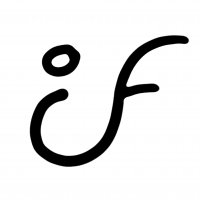
The IUF sanctions a biennial world unicycling convention and competition, the major event on the international unicycling calendar. Events include artistic (such as group, pairs, individual, standard skill, open-X), track racing (such as 100 metres, 400 metres, 800 metres, 30 metres walk the wheel, 50 metres one-foot), distance race (such as 10 kilometres, marathon) (42.195 km), muni (cross-country, uphill, downhill), street, trials, flatland, basketball and hockey.
To Visit IUF Click Here.
Awards Related To Unicycle hockey
Unicycle hockey players interrupt Community Awards:
we have an additional type of penalty known as a PENALTY GOAL in the event that an illegal playing of the ball prevents a certain goal ( For example the goalkeeper is standing on the ground with his cycle in front of the goal and a direct shot is deflected by the wheel ). In this case a goal is awarded anyway
Sample Documents Of Unicycle hockey
-Andre Agassi



